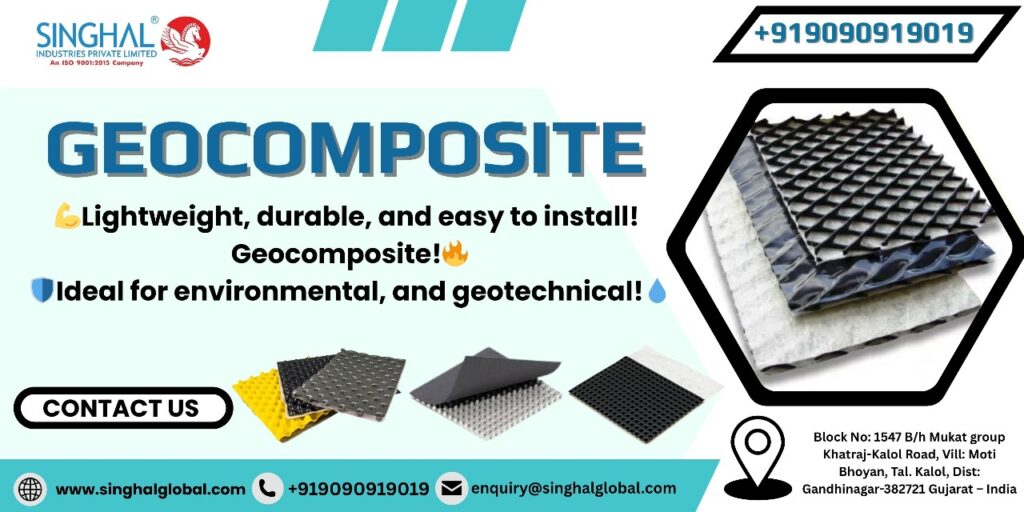When we travel along an easily connected highway, look at the impressive bridges, or traverse over a sturdy pavement, we don’t often look up to see what’s beneath these structures. Infrastructure is usually like an iceberg. What’s apparent is only a tiny fraction of the overall image. The glue that holds it all together and is what makes it last is often hidden and out of sight. One of these heroes that is not seen is the geocomposite, an engineering material that quietly alters the way our infrastructure is constructed and maintained. They don’t get the attention of the media; however, without them, some of the most ambitious projects might not be feasible.
Geocomposites may sound complex, but in simple words, they’re a smart combination of geosynthetics—materials designed specifically to solve problems in civil engineering. Imagine baking a cake with a mixture of eggs, flour, and sugar to make cakes that are more robust (and more delicious) than the ingredients it’s made of. Geocomposites also combine geotextiles (also known as geogrids), geomembranes, geo, and drainage cores in the same, resulting in a variety of problem-solvers in drainage, construction, as well as reinforcement work.
Why Geocomposites Matter
Infrastructure isn’t solely about laying bricks and pouring asphalt anymore. Climate conditions are changing rapidly—excessive floods, unpredictable rains, soil erosion; engineers need more innovative solutions. Geocomposites can fill in this gap because they are multi-tasking. They improve the soil, stop flooding, increase stability, and can extend the lifespan of a project without shouting to be noticed.
For instance, consider the Mumbai Metro or Chennai’s flood-prone roads. The traditional methods of drainage usually fail in heavy rains during monsoons, which can cause damage, waterlogging, and the notorious traffic congestion. Through the use of geocomposites beneath the railroad beds, the engineers can create constructed drainage systems and filtration devices. The result? More durable, more robust infrastructure that won’t fail after just one season of rain.
The Geocomposites Landscape in India
Demand for geocomposites across India is growing steadily because of rapid urbanization and infrastructure projects that are backed by the government. If you’re curious about the Geocomposite price in India, typically, it depends on the project’s size, type, the kind of product, and the company chosen. Prices can vary; in the case of large infrastructure companies, the discussion seldom begins with “cost.” Instead, it starts with “How much stability and durability can this product bring long-term?”
Nowadays, a lot of Geocomposites manufacture in India have expanded their operations to meet global standards and have produced high-quality drainage and reinforcement products. Geocomposites Suppliers in Ahmedabad, is home to one of the most trusted suppliers. If you are looking on the internet for geocomposites companies in Ahmedabad, you will discover companies providing services to not only Indian projects but exporting internationally, which speaks to their innovation and quality control standards.
Real-Life Examples That Hit Home
Let me give you a tiny but effective illustration. In Uttarakhand, the landslides cause frequent nightmares. The roads collapse, villages are disconnected, and safety is a risk. Engineers in the area realized that conventional retaining walls weren’t sufficient. With the use of geocomposites in the retaining structures, drainage improved, and soil erosion was slowed. The roads were able to last longer, which meant tranquility for the locals.
Another example is a bit more personal. An engineer from the civil engineering field I talked to in Geocomposites Suppliers in Ahmedabad told me that he could not sleep through the intense monsoon rains since his team was responsible for a stretch of highway that was prone to flooding. After the geocomposites were integrated, he said to me with a smile of relief, “Now, when it rains, I finally get to enjoy the sound instead of worrying if a collapse is coming.” Doesn’t it show how the most insignificant innovations provide relief to not just structures, but also to the people who live behind them?
Types of Geocomposites You Should Know
Different geocomposites are not exactly the same. Their value lies in their diversity. Different types are available to satisfy different requirements:
- Geotextile-Geonet composites: These offer excellent drainage and are often utilized for road construction or in landfills.
- Geotextile-Geogrid composites: Primarily for soil reinforcement, to avoid collapse or settlement.
- Geomembrane-Geotextile composites: Perfect for waterproofing projects such as ponds, canals, or tunnels.
- Geonet-Geotextile-Geotextile composites: Ever need filtration and separation at the same time? This is your solution.
This flexibility is what makes them an ideal solution for engineers who have to deal with difficult situations.
Why We Never Notice Them
It’s ironic, isn’t it? The composites that keep roads from bursting or buildings from flooding don’t have a chance to shine or be in the limelight. We’ll recognize the name of the architect or the name of the contractor, but not the unnoticed product that helps to make everything possible. Personally, I see geocomposites being the “introverts” of civil engineering—they complete all the work without a word, while others take the spotlight. But isn’t that exactly what reliable foundations accomplish in the real world and in buildings? They provide support and don’t require recognition.
Conclusion
If you would like to ask me, geocomposites will not just be for the present but also for the futuristic construction of India. Smart cities and sustainable roads, along with green energy initiatives gaining momentum, require materials that are able to multitask and decrease maintenance. As awareness grows in the field, the Geocomposite price in India will also be more competitive while maintaining the same quality as international standards. Infrastructure tells the tale of a nation constructing its future. Geocomposites? Geocomposites are the invisible writers of strength, durability, stability, and resilience underneath the steel and concrete that we encounter every day.
Frequently Asked Questions (FAQs)
Q1. What are the main components of geocomposite?
Geocomposites consist of a combination of two or more geosynthetic substances. The most commonly used components are geotextiles, geogrids, geomembranes, and geonets. Based on the requirements, they are paired to provide functions such as drainage, filtration, reinforcement, or protection.
Q2. What are the primary geocomposites?
The primary kinds are:
- Geotextile-Geonet composites
- Geotextile-Geogrid composites
- Geomembrane-Geotextile composites
- Geonet-Geotextile-Geotextile composites
Each has its own function but falls broadly into the categories of drainage, containment, or reinforcement.
Q3. Can geocomposites be used in road construction?
Yes, absolutely. When it comes to road construction, they’re often employed to reinforce subgrades to prevent cracks and potholes, as well as drainage built-in. In monsoon-prone areas, roads greatly benefit, stopping water from weakening and destroying the base.
Q4. What is the drainage function of geocomposites?
They provide a way for water to drain away. In the case of geotextiles, for example, when paired with geotextiles and geonets, the mixture lets water escape while also obstructing soil and debris, ensuring stability over time. Imagine it as an efficient sieve built into the dirt road or in the landfill.
Q5. Who is the largest supplier of geocomposites?
Globally, multinational companies dominate the market; however, in India, some of the most prominent companies are located in cities such as Ahmedabad or Mumbai. A lot of geocomposites suppliers from Ahmedabad have established themselves as top-tier in both export and domestic markets.









